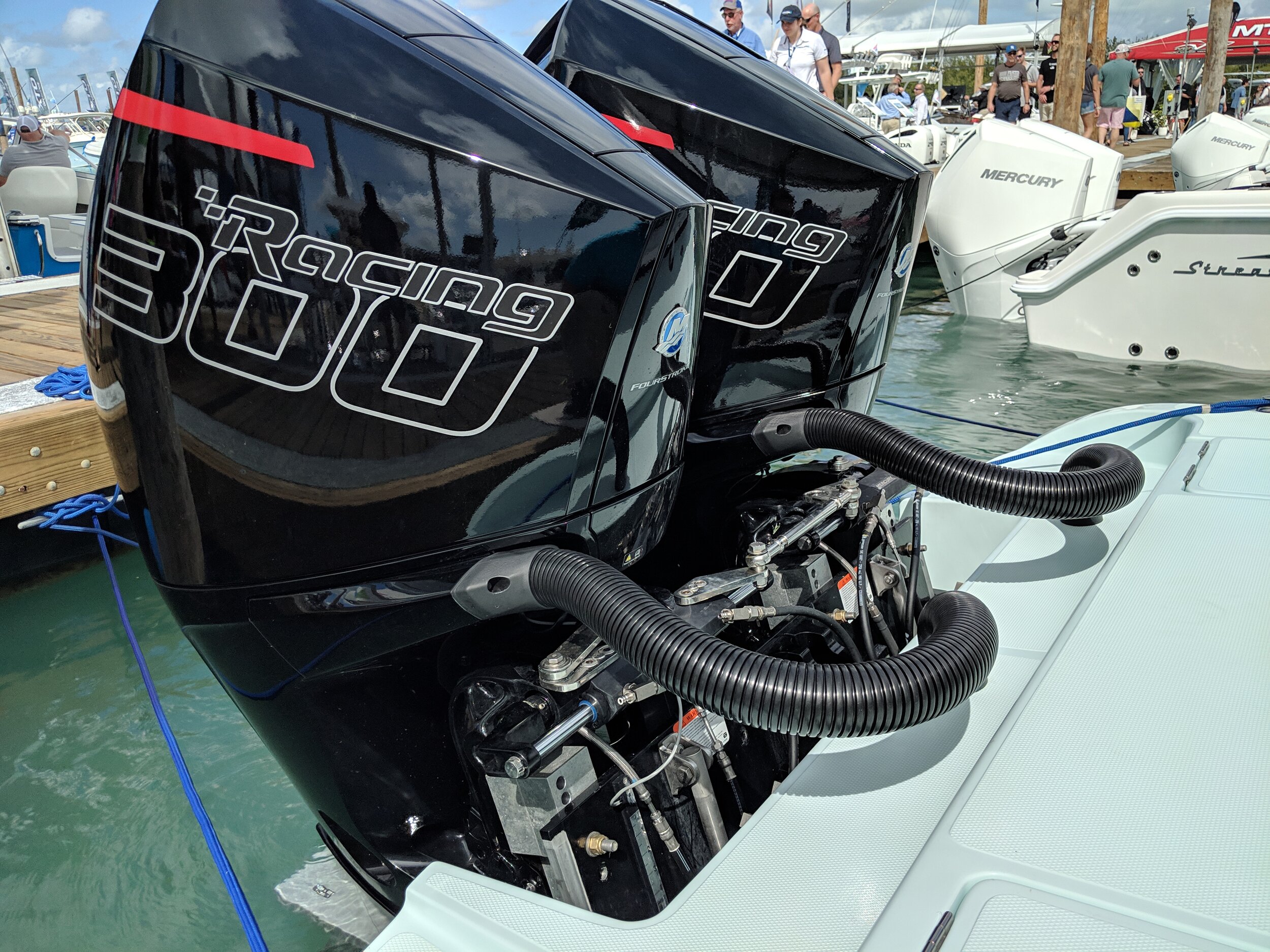Suzuki VS Honda: How do the Underdogs in the Marine Industry Outboard Market Compare?
Suzuki and Honda are underdogs in the marine industry, despite having massive parent companies behind them and being substantial automotive companies. On the water in North America Mercury and Yamaha dominate, where Suzuki has made incredible gains the last decade, Honda seems to remain content with being a marginal player. Let’s look at how the two Japanese manufacturers match up. They both have engines in the 115 to 250 HP range that are worth looking at for a repower of a bay boat, center console, or other when price is a factor. I added some tests at the end to highlight the points.
One key driver of success for Suzuki has been that they really focused on the repower market, brought in advanced features at a great value, and built very compelling engines in their market. Suzuki’s look great, they have really modern design. The larger gearcases with extremely low gearing was a strategy that worked for them. For example, the DF115 and DF140 Suzuki use 2.56:1 gear ratios. The larger 2.9L 4 cylinder DF 150 Suzuki uses a 2.5:1 ratio.
This is emblematic of a Suzuki repower. The light 140s can replace old 150s and save the buyer big money, while getting new tech, like digital controls.
Recently, Suzuki introduced more features their inline 4 cylinder 115 and 140 HP. The DF140 was the first to offer the advantages of digital, drive by wire, tech to lower HP offerings. With the same proven engine, Suzuki has fine tuned the latest 115SS to increase compression, while improving efficiency overall. As a 115, the Suzuki is competitive, especially on a heavy boat, But the 140 stands out because of it’s smaller stature and weight in that HP range. At 396 Lbs. the 140 is far lighter than any 150 HP on the market, so for weight sensitive transoms, the DF140 is excellent and the slim 2.0L engine is suited to many boats.
The Suzuki DF150 AP, is loaded with features, digital, selective rotation, and follows Yamaha’s philosophy by offering the 4 cylinder in a 150, 175 and 200 HP. A little heavy, the 2.9L is a workhorse.
Honda Marine revamped their 115 to 150HP outboards and introduced a 140 HP, replacing the 135, offering drive by wire and other features. Where Honda continues to go off course is the size and weight of their engines. The Honda range is based on the 2.4L DOHC engine, which is massive. At 115 and 140 HP, Honda can’t really compete in that range with Suzuki, or anyone else for that matter. At 490 Lbs, it’s just too heavy for most boats. The 150 is more competitive at that size. All of them run the same 2.14:1 gear ratio, which is fine for the category as a workhorse.
Although the 150 from both Honda and Suzuki is competitive in the industry, Honda went with the same block for their 115 to 140 HP offering. These are simply too big and heavy for this category, leaving them lagging Suzuki in the small mid range. These are 500 Lbs engines.
If we look at the high sales volume 115-150 HP outboard market, and compare just Honda and Suzuki, then Suzuki wins without a doubt. By offering the lighter 115-140, and a completely different 150 HP the consumer has a better choice offering with Suzuki. The Suzuki DF140 is really a class leading engine by most measures.
Suzuki wins the 115 and 140 HP vs Honda. The 140 is a class leader in the uncrowded 135/140 class, being the lightest and most featured by far. If they had an optional taller gear ratio, it would be a near perfect.
In the 200 HP and up range, it gets more interesting between the Japanese heavyweights. Suzuki utilizes their 2.9L 4 cylinder 200, with two versions, the SS with a 2:00:1 gear ratio, and the standard, with the 2.5:1 ratio. The 200 SS is a good option in this market, slimmer and lighter than a V6, with a reasonable gear ratio, in fact the gearcase itself if borrowed from the V6, while using a different gear set. When you jump to the V6 in Suzuki, the 225 HP only comes as a 25”, then it’s the DF250 and DF250 SS, which is a massive 4.0L block. Revving to 6,300 with a 2.08:1 gear ratio. The regular DF250AP is very similar. All the 150 HP and up AP engines offer selective rotation, meaning you can counter rotate the propshaft for a twin setup.
Suzuki has two options in the 300 HP category; a DF300AP, with the same setup as the 250, and the larger 4.4L engine, DF350B, with contra rotating props, also in a 350 HP version. Honda doesn’t compete here.
Suzuki offers consumers options, need more torque and a contra rotating gearcase? The big V6 is offered at 300 and 350 HP, for heavy boats. The slimmer 4.0L 225 to 300 HP is very competitive and edges out the big Hondas.
For Honda, they run a 3.5 liter V6 engine, which is a variation of their automotive 3.5L V6, just as the smaller BF115-150 uses the automotive K24. The lightest 3.5L V6 Honda is 610 Lbs, that’s crazy for a 200, basically relegating it for commercial purposes only; or just really heavy low performance boats. The 250 Honda revs to 6,300 RPM, the 200 and 225 HP can turn 6,000 RPM and all run a 2.00:1 ratio. One thing Honda nailed was the design, offering the V6 lineup in a crisp white or traditional silver, the cowling is sleek and modern.
The big Honda V6 looks great, offered in silver and crisp white, and a modern cowl. Slightly anemic for the range, and a bit heavy for a 200 HP. Honda customers don’t get a 300 either. Can it compete on a heavy boat, sure but it’s not class leading in anything.
Again, I think Honda is really hampered by their engine selection, essentially taking albatross car engines and making them marine engines. It is a bad strategy and really holds Honda back, especially in the larger engines. Honda makes great small engines, I love the 40-60 HP Hondas, all of which are light, and very competitive. Honda should rethink the 115-140 range, it has to be lighter, and compete with the rest. They need to offer the 2.4 BF150 as a 175 and possibly a 200 HP to remain competitive in the mid range as well. And, they could bump the 1.5L 90-100HP to include a 115 HP. This actually would be just an adjustment for them that would make all the difference.
If Honda bumped the V6 from 225 to 300 HP, that would make them more competitive in that range as well. Their strategy now is just slightly off. By shifting the HP up a segment; they would effectively make the engines more competitive overall. In the tests included below I highlight a perfect example how this is true by comparing a smaller BF90 Honda to a DF140 Suzuki on the same boat.
As you can see, for the underdogs, Suzuki comes out on top in all segments. It is no surprise you see more and more Suzuki outboards on the water. In North America Honda is a fringe player, globally they are much more substantial but a small change in strategy could probably help Honda gain market share in North America.
Personally, I would love to try a Suzuki 140 on a small light boat, as well as see what a 200 SS could do on some boats. That said, if you want a workhorse, Suzuki and Honda have some decent offerings. They just can’t really be made into even a semi-performance outboard.
Below are some performance comparisons with engines mentioned above.
Above is a bizarre test of a Honda 225 and a Checkmate 21 Pulsare. The closest comparison for a Suzuki I could find was a BassCat Puma and Suzuki 250SS. The fact is, the Pulsare should be a little faster than that BassCat all things being equal. Setup is always key and this Checkmate should be mid to high 70s setup well with a 225 HP. The Honda is too heavy, not the right prop or engine height. With the right setback, prop and some work it should perform much better, even with the lethargic Honda. I’m not sure how they only turned only 5450 RPM, but I would guess the gearcase was buried. That prop pitch and gear ratio should rev much higher. The Honda being 600 Lbs doesn’t help at all.
The Puma does pretty well with the Suzuki 250SS. A Mercury or Yamaha has the gear ratio and weight advantage, so you can see how that can translate to slightly higher speeds. And, compared to the Checkmate, you can see a little more time was spent setting the Puma up with the right prop and engine height. If we ran the Suzuki on the Checkmate, it would most likely be a little faster than the BassCat. They ran a 30” four blade to 6250 RPM, which seems like they were getting the most out of it. Weight, gear ratio, setup and driving are major factors in these comparisons.
Below is a different look at how weigh and gear ratio affect performance, the Suzuki 140 is great, but the gear ratio holds it back, here’s a good comparison that also shows how Honda should utilize their smaller 1.5L 4 cylinder as a 115.
I found a test with an Action Craft 1720 and a DF140, and also an Action Craft 1720 with a 90 Honda (see below). The 140 should clobber it right? No, the lighter 90, with slightly taller gears outpaces the 140. Now, the setup could is different, testing weight etc, but you see clearly how and why gear ratio is so critical in overall performance, especially in lighter faster boats. The Action Craft with the 140, 21” 3 blade, turns 6,200 and gets 43 MPH. The Honda 90, spins a smaller diameter 19” 3 blade to 6,100 at 44.7 MPH. The 2.33 ratio in the Honda vs the 2.59 ratio in the Suzuki means the Honda is turning that prop faster than the 140 can, even when the pitch is adjusted for, you can’t make up for the gearing being too low. If the Suzuki had the same ratio or even taller, it would be quite a bit faster.
The boat is almost identical but the Suzuki powered Action Craft does have more equipment, a trolling motor and power pole, so remove those and it’s probably neck and neck. Still, the cruise at 4,000 RPM and 25 MPH for the Suzuki has it lagging the Honda BF90 by 4 MPH, at 28.9 MPH and 4,000 RPM. Not a perfect comparison but a really good example of how Honda’s strategy of the heavier engines moving down is not wise. Honda makes a BF100 that is the same engine as the 90, and it would no doubt best the Suzuki DF140 here. Lighter is better, and the right gear ratio is critical. The small Honda wins here.
Here’s a video overview of the engines from the 2022 Miami Boat Show.
















